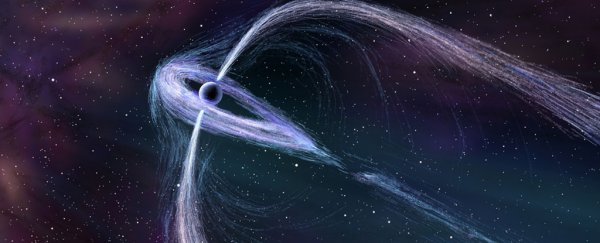Astronomers studying pulsars may have finally unravelled why these mysterious pulsating objects appear to send different kinds of signals into space – by tracking the immense cloud trails of their nebulae.
Thanks to images taken by NASA's Chandra X-ray Observatory, a new analysis of two very contrasting pulsars shows that pulsars' energy emissions may only be visible to Earth from certain angles – which could explain a mystery that's puzzled scientists up until now.
Pulsars are a kind of neutron star – an extremely dense core of matter left over once a massive star has exploded in a supernova.
What sets pulsars apart from other neutron stars are their pulsating radio wave emissions – a tightly focused beam of electromagnetic radiation that rapidly rotates around the pulsar much like the light shone from a lighthouse.
While pulsars were long categorised by the emission of these radio waves, more recently researchers have found that some pulsars also generate a different kind of energy signal – gamma rays – and the distinction has puzzled astronomers for almost a decade.
 Geminga, artist's impression. Credit: Nahks Tr'Ehnl
Geminga, artist's impression. Credit: Nahks Tr'Ehnl
"It's not fully understood why there are variations between different pulsars," says researcher Bettina Posselt from Pennsylvania State University.
"One of the main ideas here is that pulse differences have a lot to do with geometry – and it also depends on how the pulsar's spin and magnetic axes are oriented with respect to line of sight whether you see certain pulsars or not, as well as how you see them."
One of the ways scientists can study pulsars is by tracking what's called pulsar wind nebulae – clouds of energetic particles that form doughnut-shaped rings called tori, which stretch out into tail-like structures as they spin off from the rapidly rotating pulsar.
Thanks to the Chandra X-ray Observatory, scientists can now study these nebulae, which helps us understand the different kinds of magnetic activity that pulsars exhibit – and also why we only pick up certain emissions from them.
"This is one of the nicest results of our larger study of pulsar wind nebulae," says one of the team, physicist Roger W. Romani from Stanford University.
"By making the 3D structure of these winds visible, we have shown how one can trace back to the plasma injected by the pulsar at the centre."
Two very divergent kinds of pulsar wind nebulae can be seen in the pulsars Geminga – which is approximately 800 light-years from Earth – and BO355+54, which is about 3,300 light years away.
In the case of Geminga (shown above), you can see the pulsar has three distinct tails making up its nebulae. Of these, the two long tails are called lateral tails, and are thought to spin off from Geminga's magnetic poles.
These lateral tails stretch out for more than half a light-year from Geminga, while a third, shorter tail also emanates from the pulsar.
The researchers think the positioning of Geminga's poles is why we can only pick up gamma rays from the pulsar on Earth – but not radio emissions.
"The tails seem to tell us why that is," says Posselt. "For Geminga, we view the bright gamma ray pulses and the edge of the pulsar wind nebula torus, but the radio beams near the jets point off to the sides and remain unseen."
 Top Left X-ray: NASA/CXC/PSU/B.Posselt et al; Infrared: NASA/JPL-Caltech. Top Right X-ray: NASA/CXC/GWU/N.Klinger et al; Infrared: NASA/JPL-Caltech. Illustrations by Nahks Tr'Ehnl.
Top Left X-ray: NASA/CXC/PSU/B.Posselt et al; Infrared: NASA/JPL-Caltech. Top Right X-ray: NASA/CXC/GWU/N.Klinger et al; Infrared: NASA/JPL-Caltech. Illustrations by Nahks Tr'Ehnl.
By contrast, B0355+54 (pictured above alongside Geminga) has its radio waves angled at Earth, which is how we're able to detect it – even though we can't pick up its gamma rays.
"For B0355+54, a jet points nearly at us so we detect the bright radio pulses while most of the gamma-ray emission is directed in the plane of the sky and misses the Earth," says one of the team, Oleg Kargaltsev from George Washington University.
"This implies that the pulsar's spin axis direction is close to our line-of-sight direction and that the pulsar is moving nearly perpendicularly to its spin axis."
While there's still a lot to learn about pulsars, the new discoveries help explain why we've only picked up distinct emissions from these kinds of cosmic objects before – and lets researchers study particle physics in ways that would be impossible to replicate in a lab on Earth.
The findings are reported in The Astrophysical Journal.
